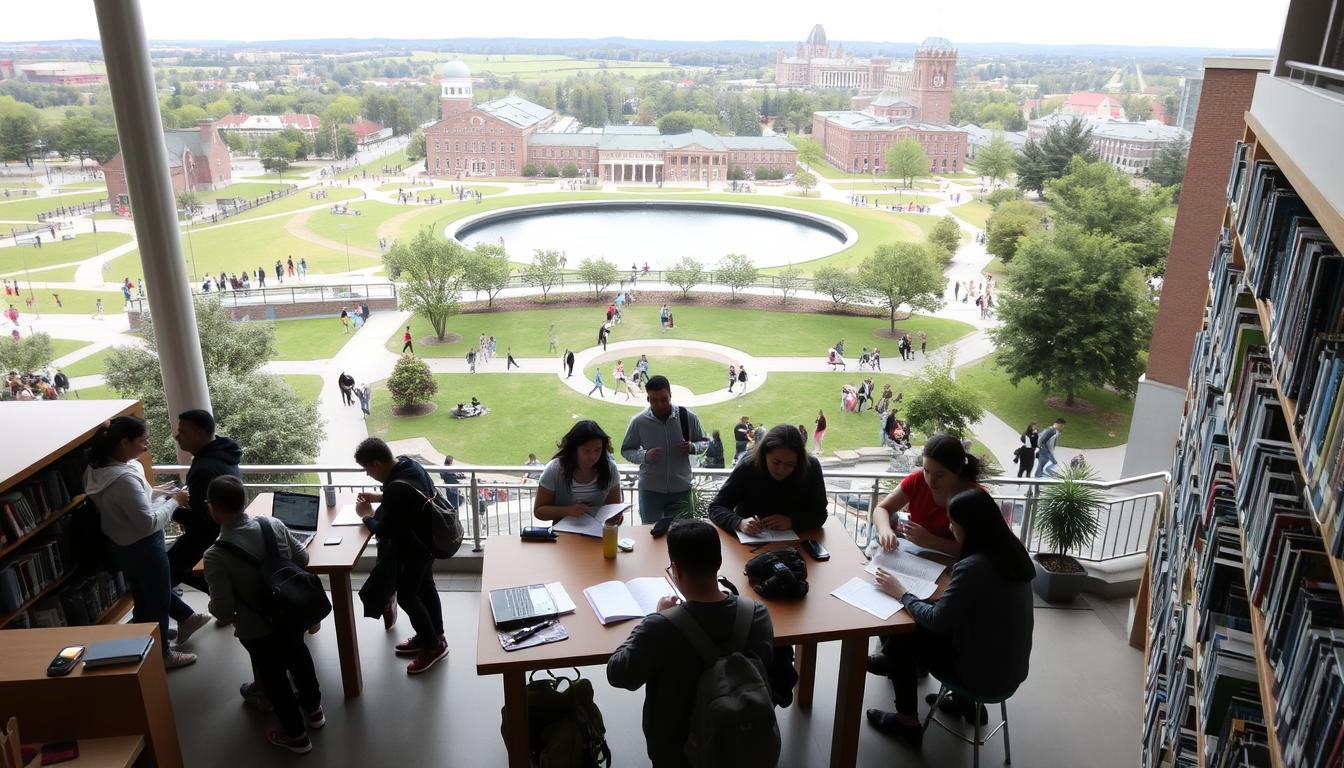There are 260 million children not in school worldwide. This shows how important accessible EDUCATION is. The world of EDUCATION offers many chances for people to learn and grow.
EDUCATION is a powerful tool. It helps people reach their goals and make a difference in their communities. We will look at the world of EDUCATION, its importance, types, and benefits. We will also talk about how technology helps in learning.
Learning gives people the knowledge and skills they need for their careers. It also helps them make a positive impact in their communities. EDUCATION is very important because it can change lives and communities for the better.
Introduction to the World of EDUCATION
The world of EDUCATION is complex and has many learning options. You can learn in traditional classrooms or online. There are many ways to get the knowledge and skills you need to succeed.
Key Takeaways
- EDUCATION is a powerful tool for personal and professional development
- Learning can take many different forms, including traditional classroom-based EDUCATION and online learning
- Accessible EDUCATION is essential for ensuring that all individuals have the opportunity to reach their full potential
- The importance of EDUCATION cannot be overstated, as it has the power to transform lives and communities
- Through learning, individuals can gain the knowledge and skills necessary to succeed in their chosen careers
Understanding the Importance of Education
Education is key for personal and societal growth. It helps people learn, grow, and live well. It starts at birth and goes on forever, in school and online.
People can find many learning chances, like online courses. These help them understand the world better and gain important skills. This makes education flexible, letting people follow their dreams and find their way.
- More job chances
- Higher pay
- Better thinking and solving problems
- More social fairness
By valuing education and using tools like school and online courses, we can reach our highest goals. This helps us and our society grow stronger.
Types of Education Systems Around the World
Education is key to a country’s growth. Different systems meet various needs. The educational resources and training programs shape these systems. In the United States, the system includes both formal and informal education.
Formal education happens in schools and universities. It offers a structured learning space. Informal education, like online courses and workshops, gives people another way to learn. Training programs are vital, teaching specific skills for certain jobs.
Some main types of education systems are:
- Formal education: schools and universities
- Informal education: online courses, workshops, and community programs
- Higher education institutions: academic programs leading to degrees and certifications
- Vocational and technical training programs: providing individuals with skills and knowledge in specific trades or industries
In summary, the world’s education systems aim to offer educational resources and training programs. They help people gain knowledge and skills for their future careers.
The Role of Technology in Education
Technology has changed education, making it easier to learn. Now, students can study at their own speed. This change also means teachers must keep up with new tech to teach well.
Some big benefits of tech in schools are:
- Personalized learning experiences
- Increased accessibility for students with disabilities
- Enhanced collaboration and communication among students and educators
Online learning platforms offer many courses and degrees. This is great for students, as they can learn from experts worldwide. Teachers also get to improve their skills through online workshops and webinars.
As tech keeps getting better, education will too. By staying updated, teachers can prepare students for a complex world. This way, students will get the skills they need to succeed.
The Impact of Education on Society
Education is key in shaping our society. It helps people understand the world better, making them more informed and active citizens. It’s vital for economic growth, as it equips people with skills for work and community service.
Education brings many benefits to society, including:
- Increased economic productivity
- Improved social mobility
- Reduced poverty and income inequality
- Enhanced social cohesion and civic engagement
When people learn new skills, they do better in work, earn more, and help their communities. This boosts the economy and social equality.
Education also fights for social equality and inclusion. It teaches people to handle a complex world. By learning, they understand different cultures and views, making society more united and welcoming.
| Benefits of Education | Impact on Society |
|---|---|
| Economic Growth and Development | Increased economic productivity, improved social mobility |
| Social Equality and Inclusion | Reduced poverty and income inequality, enhanced social cohesion and civic engagement |
Challenges Facing the Education Sector Today
The education sector is facing many challenges. One big issue is making sure everyone has access to quality education. This is hard, mainly in developing countries. The digital divide and lack of technology also make it tough for students to learn online.
Some of the key challenges facing the education sector include:
- Lack of access to quality educational resources and facilities
- Insufficient training and support for educators
- Limited access to technology and digital learning tools
- Disparities in education outcomes based on socioeconomic status and geographic location
To solve these problems, we need a team effort. Governments, schools, and private groups must work together. They should focus on improving education access and supporting learning for everyone. This can be done by investing in schools, training teachers, and making technology more available.
By tackling these challenges, we can make education fairer and better for everyone. It takes hard work and dedication. But, the rewards will be huge. We’ll have a more educated and informed society.
| Challenge | Solution |
|---|---|
| Lack of access to quality educational resources | Investing in educational infrastructure and providing access to digital learning tools |
| Insufficient training and support for educators | Providing professional development opportunities and training for educators |
| Disparities in education outcomes | Implementing programs that promote digital literacy and access to technology |
The Evolution of Educational Methods
Education has changed a lot over the years. This change is thanks to new technology and what learners want. Now, we have online courses and resources that make learning easy and flexible. Old teaching ways are now mixed with new, hands-on learning methods.
Some key benefits of these evolving educational methods include:
- Increased accessibility to learning opportunities
- Personalized learning experiences through online courses
- Improved engagement and motivation through experiential learning techniques
As more educational resources become available, using online courses is key. They help learners get new skills, explore interests, and keep up with field updates. The shift in education is a good thing, and it’s exciting to see what the future holds.
By embracing this change, both teachers and learners can use many educational resources. This includes online courses and interactive simulations. This way, learning becomes more effective and fun. It helps us reach our full educational potentials and achieve our goals.
The Importance of Early Childhood Education
Early childhood education is key for a child’s growth. It helps with learning, social skills, and emotional development. Academic studies prove that good early education leads to better future outcomes.
In the U.S., many training programs support early education. These programs help teachers and caregivers. They learn how to create a caring and learning-friendly space.
Key Developmental Stages
Children go through important stages early on. These include:
- Language and literacy development
- Social and emotional development
- Cognitive development
Programs and Initiatives in the U.S.
Here are some U.S. programs that help with early education:
| Program | Description |
|---|---|
| Head Start | A federally funded program that provides early childhood education and services to low-income children and families. |
| Early Head Start | A program that offers early education and services to infants and toddlers from low-income families. |
Career Opportunities in the Education Field
The education field has many career paths for those who love teaching and learning. You can work as a teacher, administrator, or even help shape education policies. Each role helps grow and improve the education sector.
For educators to thrive, they need to keep learning and growing. Getting advanced degrees and attending workshops are key. Online courses and training programs also help keep skills sharp and knowledge current.
Teaching and Administration Positions
Teaching and administration jobs are common in education. They involve working with students and other educators to offer quality education. Some examples include:
- Classroom teachers
- Department heads
- Principals and vice principals
- Superintendents and other district-level administrators
Education Consulting and Policy Making
There are also roles in education consulting and policy making. These jobs help schools and districts with policy, curriculum, and program implementation. Examples include:
- Education consultants
- Policy analysts
- Program evaluators
- Curriculum specialists
The education field offers many career paths for those who care about teaching and learning. By focusing on professional development and knowledge, educators can excel in their careers.
| Career Opportunity | Job Description | Required Skills and Knowledge |
|---|---|---|
| Teaching | Teach students in a classroom setting | Bachelor’s degree in education, teaching certification |
| Administration | Manage schools, districts, or other education organizations | Master’s degree in education, administration certification |
| Education Consulting | Provide expertise and guidance on education policy, curriculum development, and program implementation | Master’s degree in education, expertise in education policy and curriculum development |
The Future of Education: Trends and Predictions
Looking ahead, education will become more tailored to each student. Technology will help students learn at their own speed. They’ll focus on topics they find most interesting. This change will make learning more fun and effective.
Some key trends in education include:
- Artificial intelligence and machine learning for personalized learning plans
- More focus on social-emotional learning for essential life skills
- Increased emphasis on STEM education for science, technology, engineering, and math careers
As education evolves, staying updated with new tech and teaching methods is vital. This ensures students are ready for future challenges. They’ll have the skills and knowledge needed to thrive in a changing world.
By focusing on personalized and social-emotional learning, we can improve education. This approach prepares students for success in all aspects of life. It’s important to keep exploring new ways to enhance learning, using the latest tech and research.
The Role of Parents and Communities in Education
Parents and communities are key in supporting students’ learning. They can help students love learning and do well in school. In the United States, many schools offer online courses and other resources for parents to get involved.
Parents can join parent-teacher associations and volunteer programs. These groups let parents meet teachers, help with school events, and make decisions. Together, parents and teachers can make a supportive learning space for everyone.

- Regular communication with teachers and school administrators
- Participation in parent-teacher conferences and meetings
- Volunteering in the classroom or for school events
- Supporting online courses and other educational resources at home
Strong partnerships between schools, families, and communities are important. They help ensure all students get the support they need to succeed. Education is a team effort that needs everyone’s help and commitment.
| Engagement Strategy | Benefits |
|---|---|
| Parent-teacher associations | Improved communication, increased parental involvement |
| Volunteer programs | Enhanced school community, additional support for students |
| Online courses and resources | Increased accessibility, flexibility for students and parents |
Special Education: Understanding Individual Needs
Special education caters to students with disabilities or special needs. It’s vital to give them educational resources and training programs that fit their needs.
Key services for students with special needs include:
- Individualized education plans
- Accommodations and modifications to the curriculum
- Access to assistive technology and devices
It’s also important to know the laws that protect students with disabilities. The Individuals with Disabilities Education Act (IDEA) and Section 504 of the Rehabilitation Act are key. They ensure students with disabilities get the education they deserve.
By giving students with special needs the right educational resources and training programs, we help them succeed. This not only helps the students but also makes our society more inclusive and fair.
| Service | Description |
|---|---|
| Individualized education plans | Tailored plans to meet the unique needs of each student |
| Accommodations and modifications | Adjustments to the curriculum to ensure accessibility |
| Assistive technology and devices | Tools and devices to support students with disabilities |
Global Education Initiatives and Organizations
Global education initiatives and organizations are key in spreading education worldwide. They work to make sure everyone gets quality education, no matter where they are or who they are. These groups offer academic studies and professional development to better education and help people learn new things.
Some notable global education initiatives include:
- UNESCO’s programs for education, which focus on improving education systems and promoting literacy and numeracy skills
- The Global Goals for Education, which aim to ensure inclusive and equitable quality education for all by 2030
- Partnerships between governments, NGOs, and private sector organizations to support education initiatives and provide resources and funding
UNESCO’s Role in Education
UNESCO is a big player in education worldwide. It works to make education better, increase literacy, and help people learn new skills. UNESCO wants to make sure everyone gets quality education, no matter their background or where they live.
The Global Goals for Education
The Global Goals for Education, also known as the Sustainable Development Goals, aim to ensure inclusive and equitable quality education for all by 2030. These goals include:
| Goal | Description |
|---|---|
| Goal 4 | Ensure inclusive and equitable quality education for all |
| Target 4.1 | Ensure that all girls and boys complete free, equitable, and quality primary and secondary education |
| Target 4.2 | Ensure that all girls and boys have access to quality early childhood development, care, and pre-primary education |
The Benefits of Higher Education
Higher education is key in shaping individuals and society. It brings economic benefits, personal growth, and development. People gain valuable knowledge and skills, leading to better jobs and higher pay. This boosts a country’s economy.
In the area of knowledge acquisition, higher education lets people explore different fields. They learn to think critically and stay up-to-date with new trends. This helps them make smart choices and handle today’s world. It also helps them grow personally, becoming more independent and responsible.
Some main benefits of higher education are:
- Increased earning power
- Better job chances
- Improved critical thinking and problem-solving
- More personal fulfillment and satisfaction
- Chances for social mobility and career growth
When people go for higher education, they gain knowledge and skills. They also become more involved in their communities. This helps society grow and prosper. In the U.S., higher education is seen as a key driver of economic growth. Many schools offer programs to support EDUCATION and learning.
Investing in higher education lets people reach their goals and make a difference. It’s vital to value higher education and support efforts that promote learning and growth.
| Benefits of Higher Education | Description |
|---|---|
| Economic Advantages | Increased earning power, better job chances |
| Personal Growth and Development | Improved critical thinking and problem-solving, more personal fulfillment |
| Social Benefits | Chances for social mobility and career growth, more community involvement |
Education Policy in the United States
The United States has a complex education policy landscape. Both federal and state regulations shape the country’s education system. Laws like the Every Student Succeeds Act (ESSA) aim to improve education and reduce achievement gaps. This act gives states more freedom to design their education systems, encouraging innovative approaches to learning and teaching.
The country’s school governance is decentralized. Most decisions are made at the state and local levels. This allows for tailored education approaches, considering the unique needs of different regions and communities. Yet, it also poses challenges in ensuring consistency and equity across the country.
Federal vs. State Regulation
The federal government provides funding and oversight, while states and local districts control curriculum, assessment, and accountability. This balance is key to making education policies effective and responsive to all students’ needs.
Recent Legislative Changes
Recent changes, like the ESSA, aim to tackle issues such as teacher shortages, school infrastructure, and quality education for disadvantaged groups. These changes highlight the role of education in driving economic growth, social mobility, and individual success.
As the education landscape evolves, it’s vital to focus on policies that support learning and teaching. We must also address the unique needs and challenges of different school communities. By working together, we can build a more equitable and effective education system. This system will prepare all students for success in the 21st century.
Strategies for Effective Learning
Learning well is key to doing well in school. Today, we have many online courses and resources to help us learn. To get the most out of these, we need good learning strategies.
Managing your time and study habits is very important. By planning your day and setting goals, you can make sure you study enough. Also, taking notes, summarizing, and practicing what you’ve learned helps you remember better.
Collaborative Learning Techniques
Working with others and learning from each other can make learning more fun and engaging. This way, we share ideas and learn more deeply. Online courses use forums and group projects to help students learn together.
Some effective learning strategies include:
- Setting clear goals and objectives
- Creating a study schedule and sticking to it
- Using active learning techniques, such as summarizing and self-quizzing
- Seeking feedback and support from instructors and peers
- Leveraging online courses and educational resources to supplement learning

By using these strategies, we can make the most of online courses and resources. This leads to better grades and personal growth.
| Learning Strategy | Benefits |
|---|---|
| Time management | Improved productivity, reduced stress |
| Collaborative learning | Enhanced engagement, deeper understanding |
| Active learning techniques | Improved retention, increased motivation |
Scholarships and Financial Aid for Education
Going to school can cost a lot, but there are ways to get help. Financial aid, like training programs, can make education cheaper. In the United States, many groups offer scholarships, grants, and work-study programs to help students.
Some common financial help includes:
- Grants: Need-based financial aid that does not require repayment
- Loans: Financial assistance that must be repaid with interest
- Work-study programs: Part-time jobs that help students earn money for education expenses
- Scholarships: Merit-based financial aid that does not require repayment
To find money for school, it’s key to look into different aid options. Students should start by filling out the Free Application for Federal Student Aid (FAFSA). This helps figure out if they qualify for federal and state aid. They can also look for private scholarships and grants from organizations, foundations, and businesses.
Using these aid options can help people reach their educational goals. Whether it’s through training programs, academic studies, or other educational pursuits, aid can make education more affordable.
The Importance of Educators in the Learning Process
Educators are key in the learning journey, acting as guides and knowledge helpers. They must keep up with new teaching methods and technologies. This ensures they can help students grow both academically and personally.
The Role of Teachers as Mentors
Teachers do more than just teach facts. They guide students through learning’s ups and downs. They inspire students to think deeply and reach their highest goals.
Ongoing Professional Development for Educators
For educators to stay ahead, they need to keep learning. This means going to conferences, workshops, and getting advanced degrees. By doing so, they can tailor their teaching to fit all kinds of learners.
FAQ
What is the importance of education?
Education helps people learn, grow, and succeed. It’s a journey that lasts a lifetime. It opens doors to better jobs, fairer societies, and personal growth.
What are the different types of education systems around the world?
Education comes in many forms. You can learn in schools, online, or through vocational training. Each offers unique ways to gain knowledge and skills.
How has technology impacted the education sector?
Technology has changed education for the better. It makes learning flexible and accessible. Online platforms and blended learning mix old and new teaching methods.
What are the key challenges facing the education sector today?
Education faces big hurdles like access and technology barriers. Many lack quality education, and some struggle with technology. These issues are more common in developing countries.
How has the role of parents and communities in education evolved?
Parents and communities are now more involved in education. They support students through associations and volunteer work. This builds strong partnerships between schools and families.
What are the benefits of higher education?
Higher education brings many rewards. It leads to better jobs, higher pay, and personal growth. It also helps individuals give back to their communities.
What strategies can individuals use for effective learning?
To learn well, manage your time and develop good study habits. Group work and peer learning also boost motivation and engagement.
What types of financial assistance are available for education?
There are many ways to fund education, like scholarships and grants. Loans and work-study programs also help those facing financial barriers.
What is the importance of educators in the learning process?
Teachers are key to learning. They guide, mentor, and share knowledge. Educators need ongoing training to stay current with teaching methods and technology.








Leave a Reply